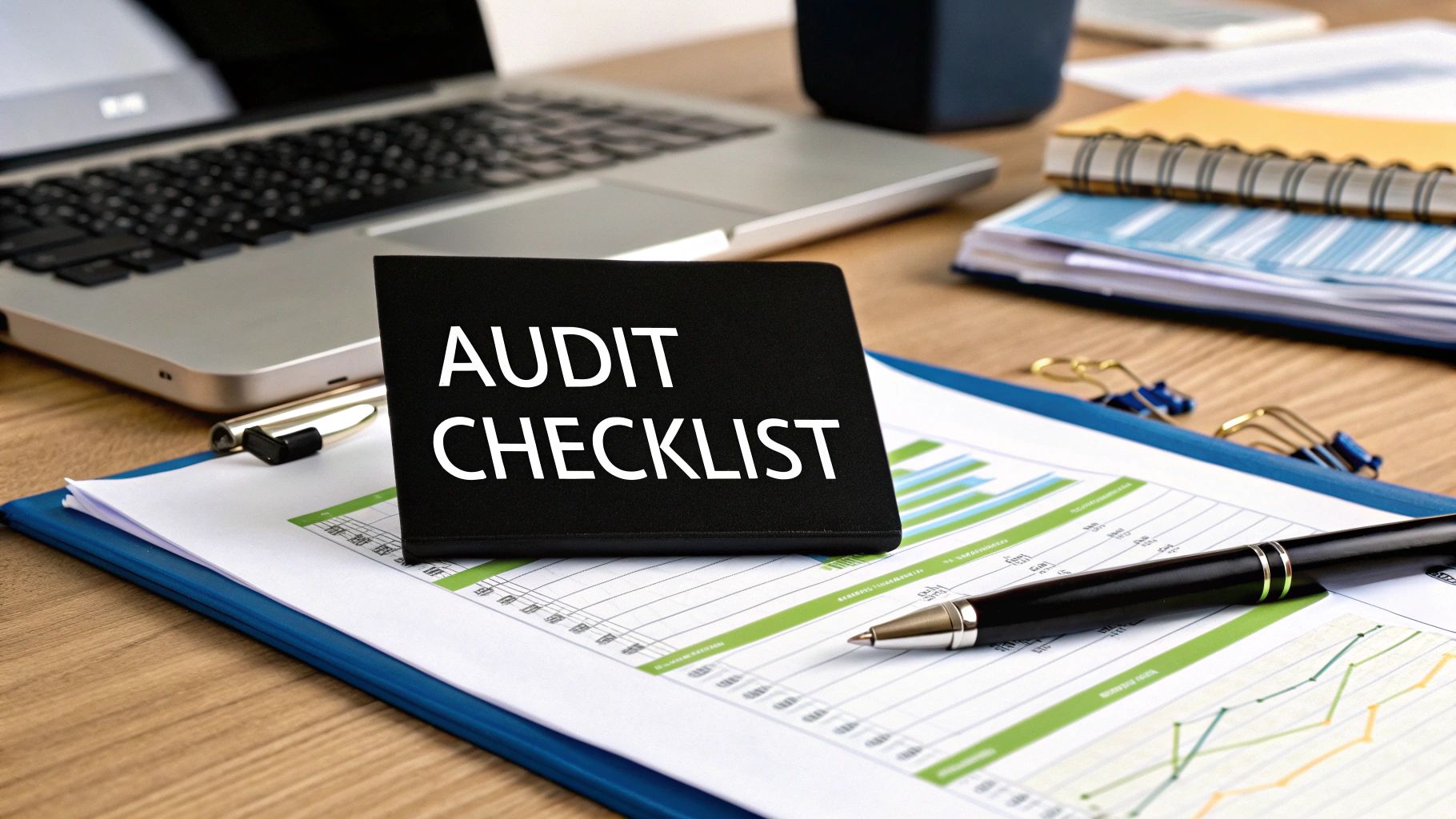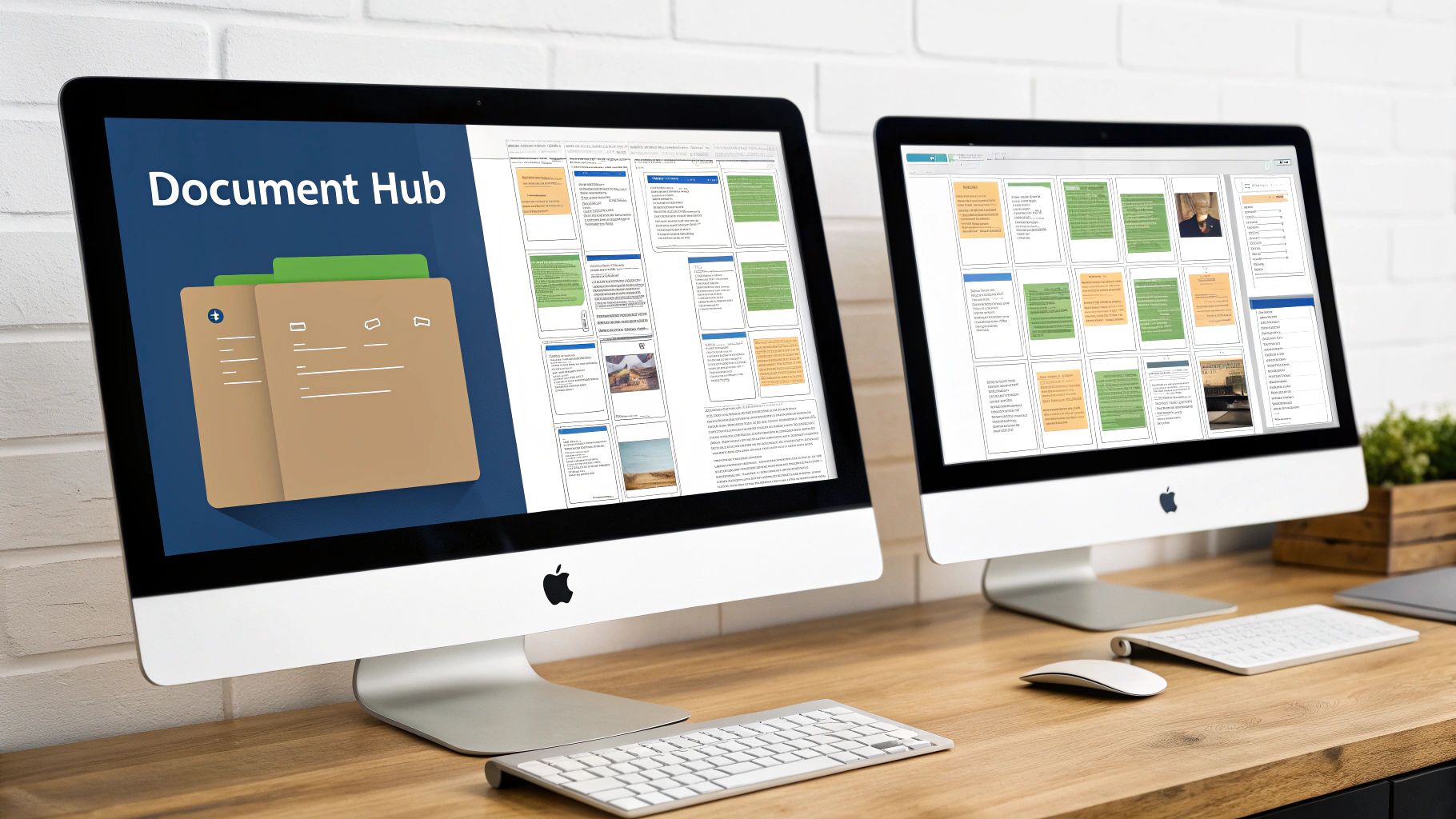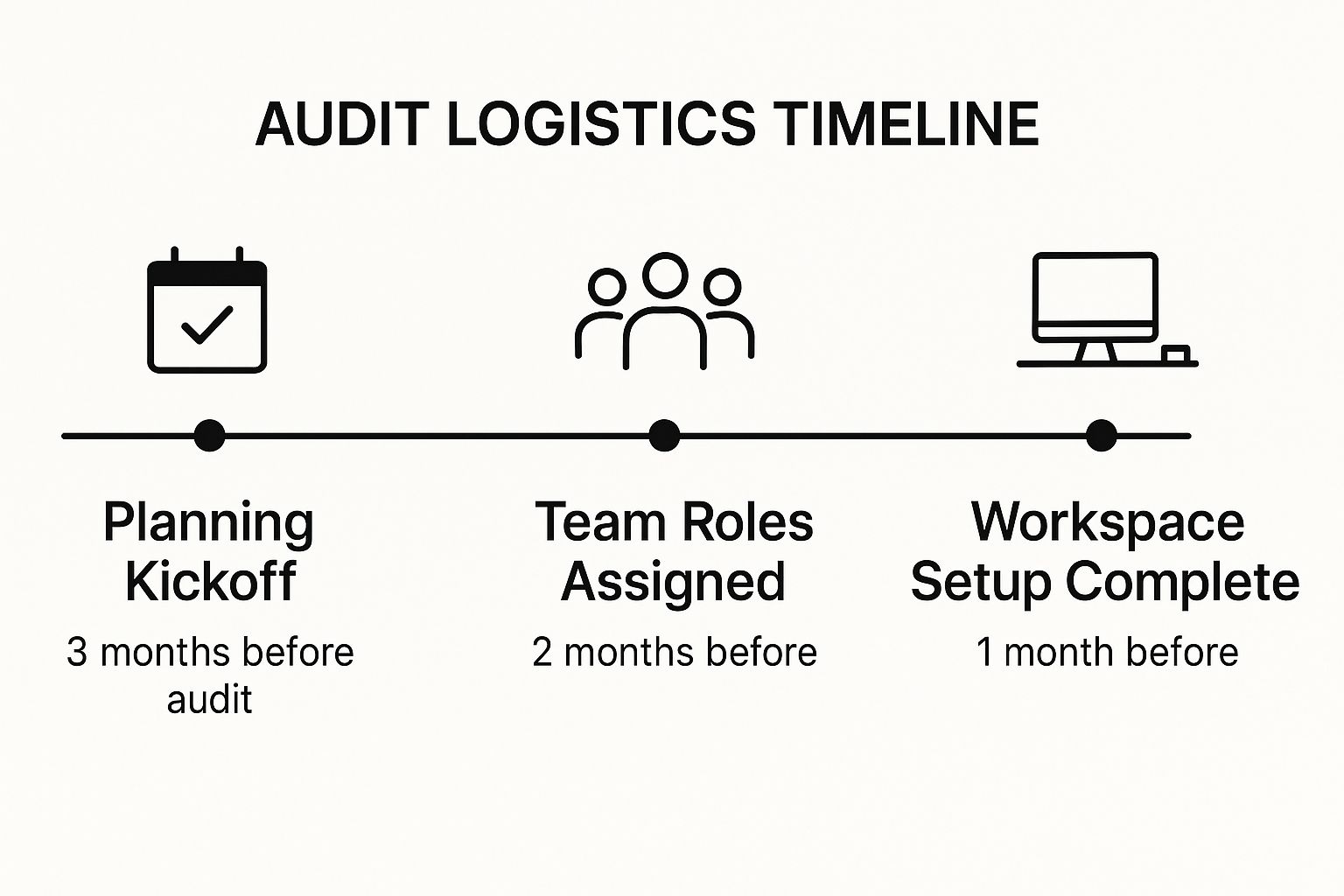Audit Preparation Checklist: 8 Key Steps for 2025 Success
Download our comprehensive audit preparation checklist to ensure a smooth process in 2025. Follow these key steps for successful audits.
Tags

The word 'audit' can send a shiver down the spine of even the most organized finance professional. It often conjures images of late nights, endless document requests, and a mountain of stress. But what if it didn't have to be that way? What if you could approach your next audit not with dread, but with the calm confidence of knowing you're fully prepared?
A successful audit isn't about scrambling at the last minute; it's the result of methodical, year-round preparation. This guide provides a comprehensive 8-step audit preparation checklist to transform your process from chaotic to controlled. We'll break down each critical stage, from organizing your documents to performing final reviews, and show you how to leverage powerful tools like GetInvoice to automate the most tedious tasks. While this article focuses on audit-specific readiness, a broader small business tax preparation checklist can provide a solid foundation for overall financial health.
By following this plan, you can ensure a smoother, faster, and more efficient audit. This checklist is your roadmap to turning pre-audit panic into predictable confidence, letting you get back to what you do best: growing your business.
1. Create a Comprehensive Document Repository
The absolute foundation of a stress-free audit is having all your financial documents in one organized, easy-to-access place. Think of it as your audit headquarters. Before an auditor asks for a single piece of paper, you should have a centralized repository containing every invoice, contract, expense report, and bank statement. This isn't just about gathering papers; it's about creating a logical, navigable system that acts as a single source of truth for your company's finances.

A well-organized repository immediately signals to auditors that your organization is professional, transparent, and in control. This proactive approach is a critical first step in any audit preparation checklist because it drastically reduces the time spent on document retrieval, minimizes disruptive back-and-forth requests, and lowers overall audit costs.
How to Build Your Audit-Ready Repository
- •Start Early: Don't wait until the audit is announced. Begin collecting and organizing documents at least 3-6 months in advance. This gives you ample time to identify and locate any missing records without the pressure of a deadline.
- •Implement Naming Conventions: Create a consistent file naming system. A simple structure like
YYYY-MM-DD_VendorName_Invoice#makes searching and sorting incredibly efficient. - •Create a Document Index: Develop a master spreadsheet or document that lists all key files, their locations, and brief descriptions. This index will be invaluable for both your team and the auditors.
- •Go Cloud-Based: Use a secure, cloud-based system like SharePoint, Google Drive, or a dedicated platform. This ensures auditors can have remote access, which is standard practice for modern audits and much more efficient than physical document review.
How GetInvoice Streamlines This Step
Manually chasing, downloading, and filing every invoice is a monumental task. GetInvoice automates this entire process. It connects directly to your email accounts and supplier portals to automatically fetch every financial document, regardless of format.
Its AI technology then extracts and verifies all the key data, organizing everything into a fully searchable, centralized hub. Need to pull records from two years ago? Just set the date range, and GetInvoice will build your historical repository in minutes. This turns a weeks-long manual project into an automated, hands-free task, ensuring your repository is always complete and audit-ready. For a deeper dive, you can learn more about how to set up a robust system with accounting document management software.
2. Conduct Internal Pre-Audit Review
Once your documents are in order, the next critical step is to essentially audit yourself. A thorough internal pre-audit review involves examining your financial statements, accounting practices, and internal controls with the same critical eye an external auditor would. This proactive "dress rehearsal" allows you to find and fix errors, discrepancies, or weak spots before they become major issues during the official audit.

Conducting a pre-audit isn't about being pessimistic; it's about being prepared. It demonstrates a commitment to financial integrity and significantly reduces the risk of unforeseen complications, adjustments, or a qualified opinion from your auditor. This step is a cornerstone of any effective audit preparation checklist because it transforms the audit from a reactive scramble into a controlled, predictable process.
How to Perform an Effective Pre-Audit
- •Focus on High-Risk Areas First: Scrutinize accounts that are prone to error or subjectivity, such as revenue recognition, inventory valuation, and complex expense accruals. These are the areas auditors will naturally examine most closely.
- •Perform Analytical Procedures: Compare current financial data to prior periods, budgets, and industry benchmarks. Unexplained variances are red flags that you can investigate and resolve ahead of time.
- •Document Findings and Resolutions: Maintain a clear log of every issue identified during the pre-audit, the steps taken to correct it, and the final resolution. This documentation will be invaluable if the auditor raises the same point.
- •Simulate Auditor Requests: Practice pulling a sample of transactions and tracing them through your system from start to finish, ensuring all supporting documentation is present and correct.
How GetInvoice Streamlines This Step
An internal review is only as good as the data you're analyzing. GetInvoice ensures the foundational data is flawless by eliminating manual data entry errors from the very beginning. Its AI-powered data extraction captures every line item from invoices with near-perfect accuracy, providing a reliable dataset for your review.
Furthermore, GetInvoice’s centralized and searchable platform makes analytical procedures incredibly efficient. You can instantly filter and analyze spending by vendor, category, or date range to spot anomalies that would be difficult to find in a manual system. By ensuring data integrity from the source, GetInvoice gives you the confidence that your internal review is based on a solid, accurate financial picture, making your pre-audit process faster and far more effective.
3. Prepare Detailed Financial Reconciliations
Beyond just collecting documents, the next critical step is proving that your financial statements are accurate. This is where reconciliations come in. A reconciliation is the process of comparing your internal financial records, like your general ledger, against external statements from banks, credit card companies, and vendors to ensure they match. It’s the essential internal control that demonstrates the integrity and completeness of your financial data.

Auditors will scrutinize your major balance sheet accounts, such as cash, accounts receivable, and accounts payable. Having detailed, well-documented reconciliations ready for review shows that you are diligent and that your balances are reliable. This part of the audit preparation checklist is non-negotiable, as it directly supports the validity of the numbers presented in your financial statements and catches discrepancies before they become major audit issues.
How to Master Your Reconciliations
- •Make It a Monthly Habit: Don't save reconciliations for year-end. Performing them monthly makes the process manageable, helps you identify and resolve issues quickly, and builds a clean, continuous record for auditors.
- •Document Everything: For every reconciling item, such as an outstanding check or a deposit in transit, provide a clear, concise explanation. Note the date, amount, and reason for the difference.
- •Implement a Review Process: Reconciliations should be prepared by one team member and reviewed and signed off by a supervisor. This two-step process adds a layer of oversight and accountability.
- •Leverage Automation: Use accounting software or specialized tools to automate the matching process. For instance, Amazon uses highly complex automated systems to reconcile millions of daily inventory and sales transactions, a feat impossible to do manually.
How GetInvoice Streamlines This Step
Reconciliation is fundamentally about matching data from invoices and receipts to your accounting entries. A major source of reconciliation headaches comes from missing or incorrectly entered invoice data. GetInvoice eliminates this problem at its source by automatically fetching and accurately extracting data from all your financial documents.
By ensuring every transaction is captured and correctly categorized from the start, GetInvoice provides a clean, reliable data set for your accounting system. This significantly reduces the number of discrepancies you need to investigate during bank or supplier statement reconciliations. For a complete guide on how technology can transform this process, see how you can automate your bookkeeping.
4. Review and Update Internal Controls Documentation
Internal controls are the policies and procedures that safeguard your company's assets, ensure the integrity of its financial reporting, and promote operational efficiency. Just having these controls isn't enough; their documentation must be a living, breathing reflection of your current business processes. Auditors will scrutinize this documentation to understand how your company mitigates risks, making it a critical component of any audit preparation checklist.
Outdated or inaccurate documentation, such as process flowcharts or control matrices, can signal significant weaknesses to auditors, even if the controls themselves are working. Regularly reviewing and refreshing these documents demonstrates a commitment to strong governance and compliance, particularly with regulations like the Sarbanes-Oxley Act (SOX). This proactive maintenance ensures your stated procedures match your actual practices, building trust and credibility.
How to Keep Your Internal Controls Documentation Current
- •Update Documentation Quarterly: Business processes evolve. Set a quarterly schedule to review and update your control documentation, especially after implementing new software, changing personnel, or shifting business strategies.
- •Use Visual Flowcharts for Complex Processes: A picture is worth a thousand words. Use visual aids like flowcharts to map out complex workflows, such as procure-to-pay or order-to-cash. This makes it easier for both your team and auditors to understand control points.
- •Involve Process Owners in Reviews: The people who execute the processes daily are your best resource. Involve them directly in the review to ensure the documentation accurately captures what really happens, not just what's supposed to happen. When doing so, don't overlook the crucial role of robust cybersecurity and data protection measures in safeguarding your organization's sensitive data.
- •Test Controls Before the Audit: Don't wait for the auditors to find a problem. Conduct your own internal tests or "walkthroughs" of key controls to verify they are operating as designed and documented.
How GetInvoice Strengthens This Step
Manual processes are often the weakest link in an internal control framework, as they are prone to human error and difficult to document consistently. GetInvoice automates the entire accounts payable workflow, from invoice receipt to payment approval, embedding strong, traceable controls directly into the system.
Every action, from data extraction to approval routing, is automatically logged, creating a clear and immutable audit trail. This eliminates the ambiguity of manual handoffs and provides auditors with concrete evidence that your financial controls are enforced systematically. With GetInvoice, your documentation for AP processes becomes a direct, automated output of the system itself, ensuring it is always accurate, current, and perfectly aligned with your operations.
5. Coordinate Audit Logistics and Team Assignments
A successful audit isn't just about having the right documents; it's also about flawless execution and collaboration. Coordinating logistics and clearly defining team roles transforms the audit from a potential administrative headache into a smooth, well-managed project. This involves planning the practicalities like schedules, communication channels, and technology access well before the auditors arrive, ensuring everyone knows their part.
This coordination is a crucial component of any audit preparation checklist because it sets the tone for the entire engagement. A well-organized logistical plan demonstrates professionalism, minimizes disruptions to daily operations, and fosters a collaborative relationship with the audit team, making the process more efficient for everyone involved.
How to Organize Your Audit Logistics
- •Create a Detailed Project Plan: Treat the audit like a project with clear milestones and deadlines. Map out key dates, from the initial planning meeting to the final report delivery. For example, Procter & Gamble is known for its structured team approach, assigning roles far in advance.
- •Assign a Dedicated Audit Liaison: Designate one or two primary points of contact for the audit team. This streamlines communication, prevents conflicting information, and ensures auditors have a direct line for their requests.
- •Establish Daily Check-in Meetings: Schedule brief, 15-minute daily meetings between your internal team and the auditors. This keeps everyone aligned, allows for quick resolution of issues, and prevents small questions from escalating into larger problems.
- •Set Up a Secure Data Room: Prepare a secure digital workspace where auditors can access necessary documents. This controlled environment ensures data security while providing the auditors with the efficient, remote access they need.
The following timeline illustrates the key logistical stages leading up to an audit.

This visual timeline emphasizes a proactive, phased approach, ensuring all logistical and team preparations are finalized well before the audit begins.
How GetInvoice Streamlines This Step
Coordinating an audit requires seamless access to financial data across multiple platforms. GetInvoice acts as a centralized data hub, integrating directly with your existing systems to provide a single source of truth. This prevents your team from having to scramble across different software to find information for the auditors.
By ensuring all invoice data is standardized and accessible from one dashboard, GetInvoice makes it easier for your assigned liaisons to fulfill auditor requests quickly and accurately. This level of organization is fundamental to a well-run audit. Discover more about how to connect your financial tools by learning about accounting software integration.
6. Address Prior Year Audit Issues and Management Letter Points
One of the most effective ways to signal competence to an auditor is to demonstrate that you take their previous feedback seriously. Addressing findings from the prior year's audit and management letter is not just about fixing past mistakes; it’s about proving your commitment to continuous improvement and strong internal controls. Ignoring these points almost guarantees they will be a focus area in the current audit, leading to repeat findings and a more challenging review.
A proactive approach to resolving past issues shows auditors that management is engaged, responsible, and dedicated to maintaining a robust financial environment. This step is a non-negotiable part of any serious audit preparation checklist because it builds trust and helps streamline the current audit by preventing auditors from dwelling on old problems.
How to Systematically Resolve Past Audit Findings
- •Create a Remediation Tracker: Use a centralized spreadsheet or project management tool to list every finding from the previous audit report and management letter. This creates a single source of truth for tracking progress.
- •Assign Clear Ownership: For each point, assign a specific individual or department as the owner responsible for its resolution. Ambiguity here is the enemy of progress.
- •Set Firm Deadlines: Establish realistic yet firm deadlines for implementing corrective actions. This creates accountability and ensures issues are resolved in a timely manner before the next audit cycle begins.
- •Document Everything: Keep detailed records of the steps taken to address each issue, including policy updates, new procedures implemented, and training sessions conducted. This documentation will serve as concrete evidence for the auditors.
How GetInvoice Helps Address Prior Issues
Many past audit issues, such as missing invoices or weak approval trails, stem from manual document management. GetInvoice helps you build a system that inherently resolves these common problems. For instance, if a prior audit noted a lack of proper authorization on expense claims, GetInvoice’s automated approval workflows ensure every document is routed correctly before being archived.
By automating the collection and organization of financial documents, GetInvoice creates an airtight, verifiable trail for every transaction. This directly addresses common management letter points related to document control and record-keeping. It allows you to show auditors not just that you fixed an old problem, but that you implemented a system to prevent it from ever happening again.
7. Validate Revenue recognition and Critical Accounting Estimates
Next on the list is ensuring your complex accounting treatments are sound, defensible, and meticulously documented. This involves a deep dive into your revenue recognition policies and other critical accounting estimates. Auditors will heavily scrutinize these areas because they rely on judgment and can significantly impact your financial statements. Getting this right demonstrates a high level of financial maturity and adherence to standards like ASC 606.
Proactively validating these items is a non-negotiable part of any modern audit preparation checklist. For example, a SaaS company like Salesforce must carefully document how it recognizes subscription revenue over time, while a company like Netflix must justify its valuation of content assets. Having clear, consistent, and well-supported methodologies prevents major audit adjustments and shows you have a firm grasp on the nuances of your business.
How to Validate Your Key Estimates and Policies
- •Review Contracts for Unique Terms: Scrutinize new or non-standard customer contracts. Look for multiple performance obligations, variable consideration, or unique payment terms that could affect how you recognize revenue.
- •Document All Significant Assumptions: For any estimate, such as the allowance for doubtful accounts or warranty liabilities, create a memo that details the assumptions, data, and methodology used.
- •Perform Sensitivity Analysis: Analyze how your financial results would change if your key assumptions were different. This helps quantify the potential risk and demonstrates a thorough review process to auditors.
- •Consult with Technical Experts: If you're dealing with a complex issue like business combinations or new accounting standards, don't hesitate to engage an external technical accounting expert to validate your approach.
How GetInvoice Streamlines This Step
While GetInvoice doesn't make accounting judgments for you, it provides the clean, organized data essential for making them. Accurate revenue recognition starts with accurate source documents. GetInvoice ensures every sales invoice and customer contract is captured, digitized, and categorized correctly.
This gives your team a reliable data foundation to apply revenue recognition rules. You can easily pull all contracts for a specific period or customer to analyze performance obligations. By automating the data collection, GetInvoice frees up your finance team to focus on high-value tasks like performing sensitivity analysis and documenting key assumptions, rather than manually chasing down paperwork.
8. Execute Final Pre-Audit Testing and Sign-offs
The final step before the auditors arrive is to conduct your own internal "dress rehearsal." This involves performing a last-minute series of checks and securing formal sign-offs from key stakeholders. This crucial action validates that all previous preparation steps are complete and provides the confidence needed to enter the audit with a united, organized front. It's the ultimate quality control check on your internal processes and a capstone to your audit preparation checklist.
Think of it like a final walkthrough before an open house; you're spotting and fixing any last-minute issues before the guests (auditors) arrive. This shows a high level of diligence and internal control, setting a positive tone for the entire engagement. This final verification minimizes the chances of unexpected surprises and ensures everyone is on the same page.
How to Conduct Final Testing and Approvals
- •Use Standardized Checklists: Create a master checklist that covers every area of preparation, from document availability to system access. Go through it point by point to ensure nothing was missed.
- •Perform a Final Walkthrough: Schedule a brief meeting with your internal audit team or key finance personnel to review the prepared documents and processes one last time. This is a great time to simulate potential auditor questions.
- •Obtain Written Confirmations: Get formal, written sign-offs from department heads (e.g., HR, Sales, IT) confirming that their relevant data and documentation are complete and accurate. This creates accountability across the organization.
- •Allow for Buffer Time: Complete this final review at least a few days before the audit's official start date. This gives you a small window to correct any minor discrepancies you uncover without the pressure of a looming deadline.
Audit Preparation Checklist Comparison
| Item Title | 🔄 Implementation Complexity | 💡 Resource Requirements | 📊 Expected Outcomes | ⭐ Key Advantages | ⚡ Ideal Use Cases |
|---|---|---|---|---|---|
| Create a Comprehensive Document Repository | Medium-High: Setup and ongoing maintenance | Cross-functional teams; IT and finance | Faster audits; reduced document requests | Reduces audit time and costs; enhances preparedness | Organizations needing centralized audit documentation |
| Conduct Internal Pre-Audit Review | High: Requires skilled staff and analytical tools | Skilled internal auditors; possible consultants | Early issue detection; improved financial accuracy | Identifies problems early; lowers external fees | Companies aiming to minimize external audit surprises |
| Prepare Detailed Financial Reconciliations | High: Labor-intensive and detail-oriented | Accounting experts; automated tools recommended | Accurate account balances; strong financial controls | Ensures account accuracy; facilitates audit testing | Firms with complex balance sheets needing precision |
| Review and Update Internal Controls Documentation | Medium-High: Extensive documentation and frequent updates | Control owners; compliance teams | Compliance assurance; identifies control weaknesses | Improves operational efficiency; facilitates audits | Public companies or regulated entities |
| Coordinate Audit Logistics and Team Assignments | Medium: Cross-department coordination and scheduling | Project managers; audit liaisons | Smooth audit process; minimal disruption | Efficient resource use; clear communication | Complex audits requiring coordinated teamwork |
| Address Prior Year Audit Issues and Management Letter Points | Medium: Resource-intensive corrective actions | Management and audit committees | Reduced audit risk; improved controls | Demonstrates governance; shows audit responsiveness | Companies with outstanding prior audit concerns |
| Validate Revenue Recognition and Critical Accounting Estimates | High: Requires technical accounting expertise | Specialized accounting professionals | Compliance with standards; reduced misstatement risk | Supports financial reliability; audit trail maintained | Entities with complex revenue and estimates |
| Execute Final Pre-Audit Testing and Sign-offs | Medium: Intense final review and approvals | Management and key stakeholders | Audit readiness assurance; last-minute issue identification | Ensures smooth audit start; management accountability | All organizations before audit commencement |
From Checklist to Checkmate: Making Your Next Audit a Win
Navigating the complexities of an audit can feel like a high-stakes game, but it doesn’t have to end in a stressful stalemate. By diligently working through this audit preparation checklist, you transform the entire process from a reactive scramble into a proactive strategy. The journey we've outlined, from creating a centralized document repository to executing final pre-audit sign-offs, provides a clear, actionable roadmap to financial integrity and operational excellence.
The core principle is simple: audit readiness is not a seasonal event. It's a year-round commitment to meticulous record-keeping, robust internal controls, and transparent financial reporting. Each step, whether it’s conducting a pre-audit review or addressing prior year findings, builds upon the last, creating a powerful system of accountability. This proactive stance does more than just prepare you for the auditors; it strengthens your entire financial foundation, giving stakeholders, investors, and leadership unparalleled confidence in your numbers.
Key Takeaways for Audit Success
Remember these critical pillars as you implement your strategy:
- •Systematize Everything: Don't leave documentation to chance. Use tools like GetInvoice to create a single source of truth where every invoice, receipt, and contract is automatically captured and organized.
- •Practice Makes Perfect: Your internal pre-audit review is your dress rehearsal. Treat it with the same seriousness as the main event to identify and fix issues before they become external findings.
- •Communication is Non-Negotiable: Keeping auditors, management, and your internal team aligned on logistics, timelines, and responsibilities prevents misunderstandings and demonstrates professional competence.
Mastering this audit preparation checklist is more than just an exercise in compliance; it's a strategic business advantage. It minimizes disruptions, reduces audit fees, and turns a potentially adversarial process into a collaborative review that can uncover opportunities for improvement. To empower your journey from preparation to triumph, consider exploring other useful business checklists that can help streamline various aspects of your operations.
Ultimately, the goal is to walk into every audit meeting not with apprehension, but with the quiet confidence that comes from being thoroughly prepared. You have the checklist, you have the strategy, and with the right tools, you have the power to make your next audit a decisive win for your organization.
Ready to automate the most tedious parts of your audit preparation checklist? See how GetInvoice transforms document collection and data entry into a seamless, audit-ready workflow. Try GetInvoice today and turn audit stress into audit success.